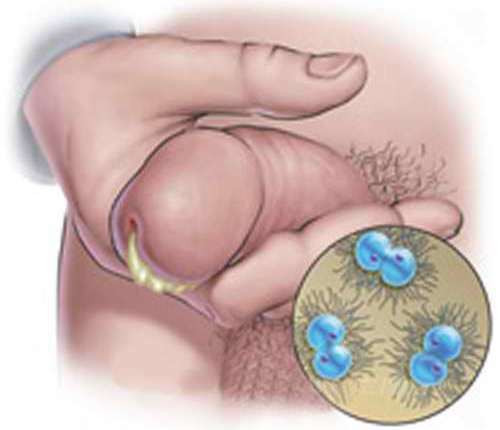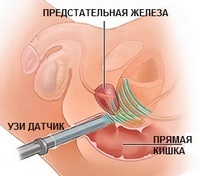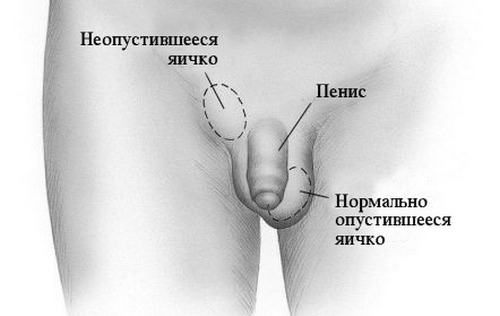Detail of testicular semenoma: causes, symptoms, stages and prognosis for life
Seminoma of the testicle is one of the varieties of malignant tumors of the male genital organs( testes).It develops from embryonic cells that form testicular tissues and is also called testicular cancer.
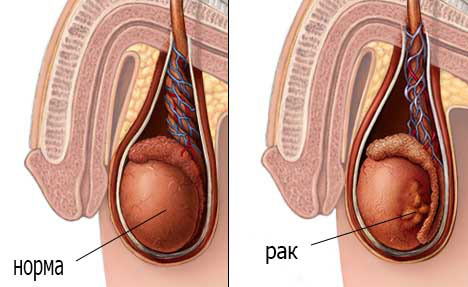
Seminoma of the testicle is one of the varieties of testicular cancer.
- 1 Contents Overview
- 2 Symptoms and flow classification
- 3 seminoma testicular disease in stages
- 4
- 5 Diagnosis Treatment Prevention
- 6
- 7 forecast
General
disease occurs infrequently. The share of testicular cancer among malignant tumors that men suffer is about 2%.However, there is a tendency for growth over the past decades, which causes doctors to be very wary.
The causes of development of testicular semenoma, like any malignant formation, are not completely known. Among the predisposing factors and heredity are considered the most significant cryptorchidism( undescended testicle into the scrotum during fetal development).In a number of patients in the anamnesis there were injuries of the genital organs, endocrine pathologies were noted.
Symptoms and course of
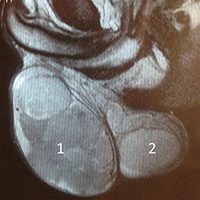
Symnoma, tenderness, swelling and enlargement in testicle size are observed.
Clinical manifestations of testicular seminaloma depend on the stage of the disease.
In the initial period, patients independently detect the compaction of the testicle and the presence of solid formation on it. Later, soreness appears in the testicle and scrotum, the swelling of the testicle and its increase in size.
As the disease progresses, pain occurs in the groin and back. This is due to the spread of metastases to the regional lymph nodes. Edema of the legs may develop due to compression of the veins. Significantly enlarged metastatic conglomerates in the groin can sometimes squeeze the ureter, which leads to a delay in urination. Distant metastasis, as a rule, affects the lungs. This involves coughing up blood and shortness of breath. If metastases spread to the liver, then jaundice develops, pain in the right hypochondrium, ascites( fluid in the abdominal cavity).When the metastases are localized in bones, intense lomiting pain appears in them.
Typical symptoms of cancer intoxication characteristic of any type of cancer - general weakness, weight loss, fatigue, lethargy, and typical of testicular seminoma, especially for progression. Classification
seminoma testicular diseases
- in stages Stage 1 - tumor locally defined, the egg is not increased, no seals and edema.
- step 2 - are attached to the tumor lesion testicular tissue, with development of edema, and changing the shape of the seal testis.
- Stage 3 - the lesions of the local lymph nodes join the above changes.
- Stage 4 - defeat metastases of distant organs and body systems.
Diagnosis
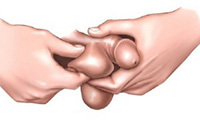
When palpation of the testis, seminoma is defined as a dense formation.
The diagnosis of seminoma begins with the correct interpretation of the patient's complaints and a doctor's examination. At a palpation the dense formation, spliced with a tissue of a testicle is defined.
Typically, the dimensions of the seminoma are 5-8 cm, and the tumor is well visualized by ultrasound. Puncture biopsy confirms the morphological component of the tumor.
In a special analysis of blood are specific markers of tumor -. Alpha-fetoprotein and beta-human chorionic gonadotropin, etc. It is important for very small amounts of education, when the tumor is almost not visible.
In order to understand whether cancer is spreading to regional lymph nodes and further to vital organs, a number of additional studies are needed. The most informative is computerized tomography, in which the lymph nodes of the groin, peritoneum and mediastinum are metastasized. Also, the diagnosis helps to provide an overview radiograph of the abdominal and thoracic cavity. The latter helps to see metastases in the lungs.
Treatment of
In the treatment of seminoma testicles adhere to the basic principles used in the therapy of cancer.
First of all, a surgical operation is performed to remove the tumor. The testicle is most often excised completely along with the spermatic cord. If regional and retroperitoneal lymph nodes are affected, then they are excised. Radiation and chemotherapy are then carried out to finally suppress the growth of tumor cells. The choice of postoperative therapy depends on the degree of prevalence of the process and the depth of the damage to organs and systems.
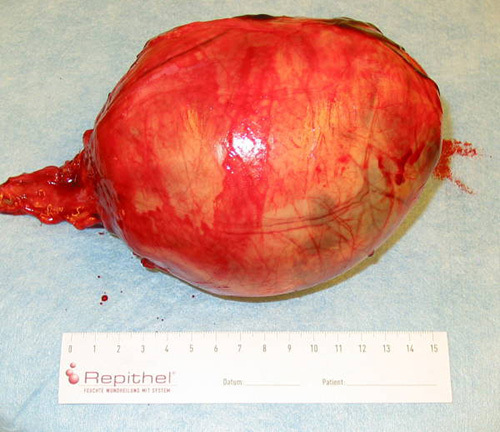
Remote testicular semizonoma.
In the early stages of the disease, it is possible to completely restrict radiation therapy to the inguinal and retroperitoneal areas. In the case of extensive cancer development and with ineffective treatment( the threat of further development of metastasis) several courses of chemotherapy are used.
Sometimes the tumor spreads to the second testicle. In this case, surgeons use a bilateral orchiectomy( removal of both testicles).As a consequence, the patient develops a decrease in testosterone levels, which is produced in testicles, which requires constant hormone replacement therapy.
Seminoma of the testicles, as already mentioned, is often found in young patients who do not yet have their children. In addition, the defeat of the seminoma happens even in childhood. In such cases, if the disease is detected at an early stage and the tumor is clearly localized, an organ-preserving operation is performed, i.e., the tumor is excised while the testicle remains. This requires increased alertness when observing the patient for the possibility of relapse.
Prevention
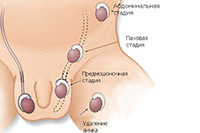
Timely treatment of cryptorchidism is the prevention of the development of cancer education.
When talking about the prevention of primary testicular semenoma, attention should be paid to the timely treatment of cryptorchidism. Patients who underwent an operation to lower the testicle into the scrotum require close observation throughout their life, as, according to statistics, they most often develop a tumor. Also, avoid genital injuries and treat inflammatory diseases of the genital area in time.
Patients who underwent surgery to remove seminoma require continuous monitoring. In the first year after discharge, a general examination, including blood on oncomarkers, is necessary once every 2 months. For the second year, patients are observed at least once every three months. Next year - once a quarter. In the future, depending on the patient's condition, the examination is carried out 1 time in six months or less.
Forecast
1st stage. With early diagnosis and timely comprehensive treatment, the prognosis is quite favorable. Patients with the first stage of the disease after the operation, as a rule, completely recover( up to 95%) and lead a full life, including having children.
2nd stage. In the second stage of the disease, against a background of generally favorable outcome, there is a higher risk of recurrence( 15-20% of patients are at risk of getting sick again within the next five years).Such patients require close monitoring during this period.
3-4 stage. The prognosis for the third and fourth stages depends on the size of the tumor, the prevalence of metastases and the degree of damage to vital organs and body systems.
Thus, the key to recovering a patient is the earliest diagnosis of the disease and timely correct treatment.
Recommended for viewing:

